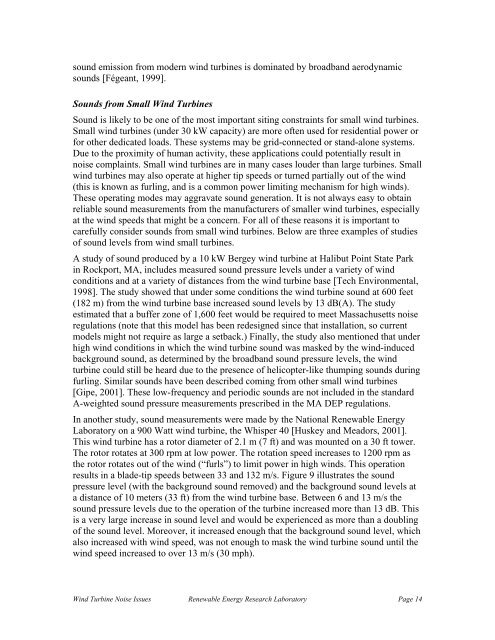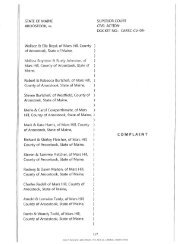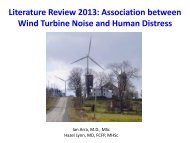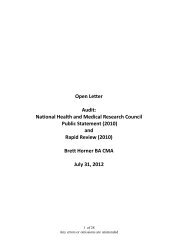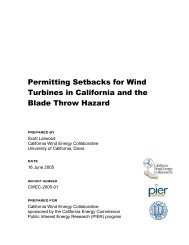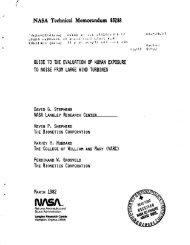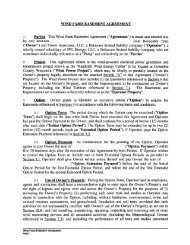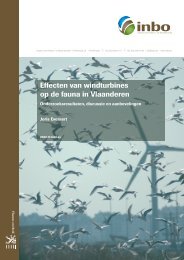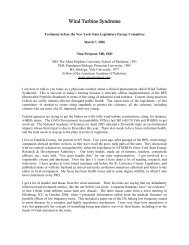Noise White Paper Outline - Minuteman Wind, LLC
Noise White Paper Outline - Minuteman Wind, LLC
Noise White Paper Outline - Minuteman Wind, LLC
You also want an ePaper? Increase the reach of your titles
YUMPU automatically turns print PDFs into web optimized ePapers that Google loves.
sound emission from modern wind turbines is dominated by broadband aerodynamicsounds [Fégeant, 1999].Sounds from Small <strong>Wind</strong> TurbinesSound is likely to be one of the most important siting constraints for small wind turbines.Small wind turbines (under 30 kW capacity) are more often used for residential power orfor other dedicated loads. These systems may be grid-connected or stand-alone systems.Due to the proximity of human activity, these applications could potentially result innoise complaints. Small wind turbines are in many cases louder than large turbines. Smallwind turbines may also operate at higher tip speeds or turned partially out of the wind(this is known as furling, and is a common power limiting mechanism for high winds).These operating modes may aggravate sound generation. It is not always easy to obtainreliable sound measurements from the manufacturers of smaller wind turbines, especiallyat the wind speeds that might be a concern. For all of these reasons it is important tocarefully consider sounds from small wind turbines. Below are three examples of studiesof sound levels from wind small turbines.A study of sound produced by a 10 kW Bergey wind turbine at Halibut Point State Parkin Rockport, MA, includes measured sound pressure levels under a variety of windconditions and at a variety of distances from the wind turbine base [Tech Environmental,1998]. The study showed that under some conditions the wind turbine sound at 600 feet(182 m) from the wind turbine base increased sound levels by 13 dB(A). The studyestimated that a buffer zone of 1,600 feet would be required to meet Massachusetts noiseregulations (note that this model has been redesigned since that installation, so currentmodels might not require as large a setback.) Finally, the study also mentioned that underhigh wind conditions in which the wind turbine sound was masked by the wind-inducedbackground sound, as determined by the broadband sound pressure levels, the windturbine could still be heard due to the presence of helicopter-like thumping sounds duringfurling. Similar sounds have been described coming from other small wind turbines[Gipe, 2001]. These low-frequency and periodic sounds are not included in the standardA-weighted sound pressure measurements prescribed in the MA DEP regulations.In another study, sound measurements were made by the National Renewable EnergyLaboratory on a 900 Watt wind turbine, the Whisper 40 [Huskey and Meadors, 2001].This wind turbine has a rotor diameter of 2.1 m (7 ft) and was mounted on a 30 ft tower.The rotor rotates at 300 rpm at low power. The rotation speed increases to 1200 rpm asthe rotor rotates out of the wind (“furls”) to limit power in high winds. This operationresults in a blade-tip speeds between 33 and 132 m/s. Figure 9 illustrates the soundpressure level (with the background sound removed) and the background sound levels ata distance of 10 meters (33 ft) from the wind turbine base. Between 6 and 13 m/s thesound pressure levels due to the operation of the turbine increased more than 13 dB. Thisis a very large increase in sound level and would be experienced as more than a doublingof the sound level. Moreover, it increased enough that the background sound level, whichalso increased with wind speed, was not enough to mask the wind turbine sound until thewind speed increased to over 13 m/s (30 mph).<strong>Wind</strong> Turbine <strong>Noise</strong> Issues Renewable Energy Research Laboratory Page 14


